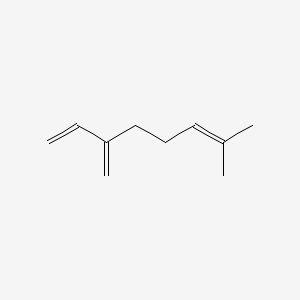| Authors | Title | Published | Journal | PubMed Link |
|---|---|---|---|---|
| Padalia RC et al. | Chemical composition of leaf and root essential oils of Boenninghausenia albiflora Reichb. from northern India. | 2012 | Nat. Prod. Res. | pmid:22111591 |
| Quartu M et al. | Effect of acute administration of Pistacia lentiscus L. essential oil on rat cerebral cortex following transient bilateral common carotid artery occlusion. | 2012 | Lipids Health Dis | pmid:22239952 |
| Aros D et al. | Volatile emissions of scented Alstroemeria genotypes are dominated by terpenes, and a myrcene synthase gene is highly expressed in scented Alstroemeria flowers. | 2012 | J. Exp. Bot. | pmid:22268153 |
| Erbilgin N and Colgan LJ | Differential effects of plant ontogeny and damage type on phloem and foliage monoterpenes in jack pine (Pinus banksiana). | 2012 | Tree Physiol. | pmid:22659460 |
| Lüddeke F and Harder J | Enantiospecific (S)-(+)-linalool formation from beta-myrcene by linalool dehydratase-isomerase. | 2011 Jul-Aug | Z. Naturforsch., C, J. Biosci. | pmid:21950166 |
| Shah G et al. | Scientific basis for the therapeutic use of Cymbopogon citratus, stapf (Lemon grass). | 2011 | J Adv Pharm Technol Res | pmid:22171285 |
| Mahendra P and Bisht S | Anti-anxiety activity of Coriandrum sativum assessed using different experimental anxiety models. | 2011 | Indian J Pharmacol | pmid:22022003 |
| Zhao T et al. | Induced terpene accumulation in Norway spruce inhibits bark beetle colonization in a dose-dependent manner. | 2011 | PLoS ONE | pmid:22028932 |
| Vallianou I et al. | Camphene, a plant-derived monoterpene, reduces plasma cholesterol and triglycerides in hyperlipidemic rats independently of HMG-CoA reductase activity. | 2011 | PLoS ONE | pmid:22073134 |
| Payo DA et al. | Variability of non-polar secondary metabolites in the red alga Portieria. | 2011 | Mar Drugs | pmid:22163195 |
Myrcene
Myrcene is a lipid of Prenol Lipids (PR) class. Myrcene is associated with abnormalities such as Hypomenorrhea, abnormal fragmented structure, Nephrosis, Renal tubular disorder and Kidney Diseases. The involved functions are known as Anabolism, Gene Expression, Protein Biosynthesis, Mutation and Selection, Genetic. Myrcene often locates in Plastids, Proboscis, Body tissue, Clone and soluble. The associated genes with Myrcene are TTPA gene, monoterpene synthase, Genome, 4S-limonene synthase and Homologous Gene. The related lipids are Pinene, Octanols, Membrane Lipids and Fatty Acids, Unsaturated.
Cross Reference
Introduction
To understand associated biological information of Myrcene, we collected biological information of abnormalities, associated pathways, cellular/molecular locations, biological functions, related genes/proteins, lipids and common seen animal/experimental models with organized paragraphs from literatures.
What diseases are associated with Myrcene?
Myrcene is suspected in Nephrosis, Kidney Diseases, Dehydration, Hypomenorrhea, Renal tubular disorder and other diseases in descending order of the highest number of associated sentences.
Related references are mostly published in these journals:
| Disease | Cross reference | Weighted score | Related literature |
|---|
No disease MeSH terms mapped to the current reference collection.
PubChem Associated disorders and diseases
What pathways are associated with Myrcene
There are no associated biomedical information in the current reference collection.
PubChem Biomolecular Interactions and Pathways
Link to PubChem Biomolecular Interactions and PathwaysWhat cellular locations are associated with Myrcene?
Visualization in cellular structure
Associated locations are in red color. Not associated locations are in black.
Related references are published most in these journals:
| Location | Cross reference | Weighted score | Related literatures |
|---|
What functions are associated with Myrcene?
Related references are published most in these journals:
| Function | Cross reference | Weighted score | Related literatures |
|---|
What lipids are associated with Myrcene?
Related references are published most in these journals:
| Lipid concept | Cross reference | Weighted score | Related literatures |
|---|
What genes are associated with Myrcene?
Related references are published most in these journals:
| Gene | Cross reference | Weighted score | Related literatures |
|---|
What common seen animal models are associated with Myrcene?
There are no associated biomedical information in the current reference collection.
